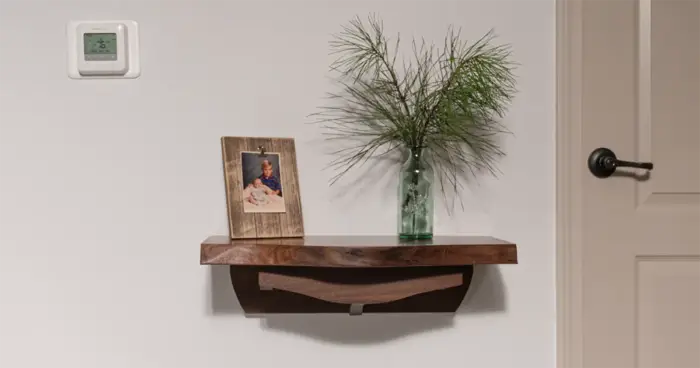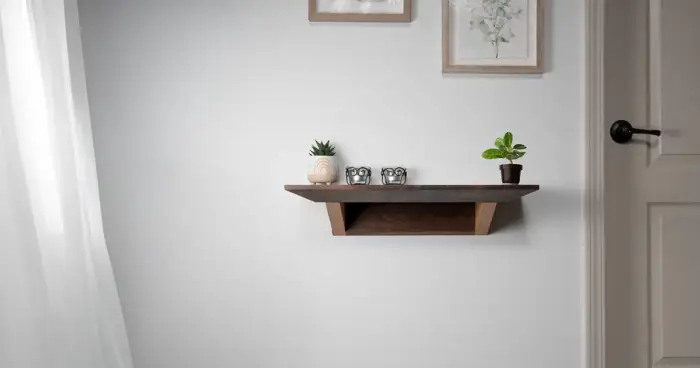I was surfing the internet last night looking for some wood, some slabs, and maybe just a little inspiration when I stumbled across this slab on Cook Woods website (found here). A beautifully figured Padauk slab and I immediately fell in love. It was calling my name. I knew I needed to create something with this piece. I think that something should be a River Table! So here I am, writing this blog, getting ready to send an email out to our customers to see who would love to have this in their home. Is it you?
The rough dimensions of this piece are 110” x 28 ¾” (at its widest point) and 24“(at its narrowest point) and 1 1/8” thick. My heart raced, as in my mind’s eye, I saw a beautiful epoxy river table waiting to emerge from this slab. If you inspect the image, you can see the figure in this slab. I estimate that pomelle figuring is covering about 60 to 70 % of this River Table in disguise. The definition of Pomelle figuring varies in the wood working community. I am referring to the look that resembles a puddle’s surface during a light rain. While it is present over a large percentage of this slab, it is subtle. Which makes it even more appealing. It is not over the top like some other wood species can get. For example: This piece of Sapele Pomelle.
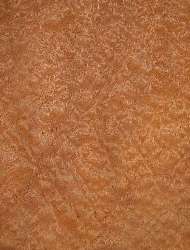
Which is beautiful in its own right and in its own application. However the subtleness of the figuring in this Padauk slab is simply stunning.
Do you see what I see? | Epoxy River Table
It is just a few days after Christmas as I am writing this and my head is still full of Christmas Carols. I see one of the most original tables, table tops, or epoxy tables I’ve seen in a while, and the size is perfect for a dining table.
This is what my mind’s eye saw when it first laid eyes on this slab. This image represents an epoxy river table which is approximately 36” wide and 84” long (arguably the perfect dining room table size). As you can see we are suggesting ripping this slab right down the center and putting the live edge (the sapwood) facing inside and making that area the river.
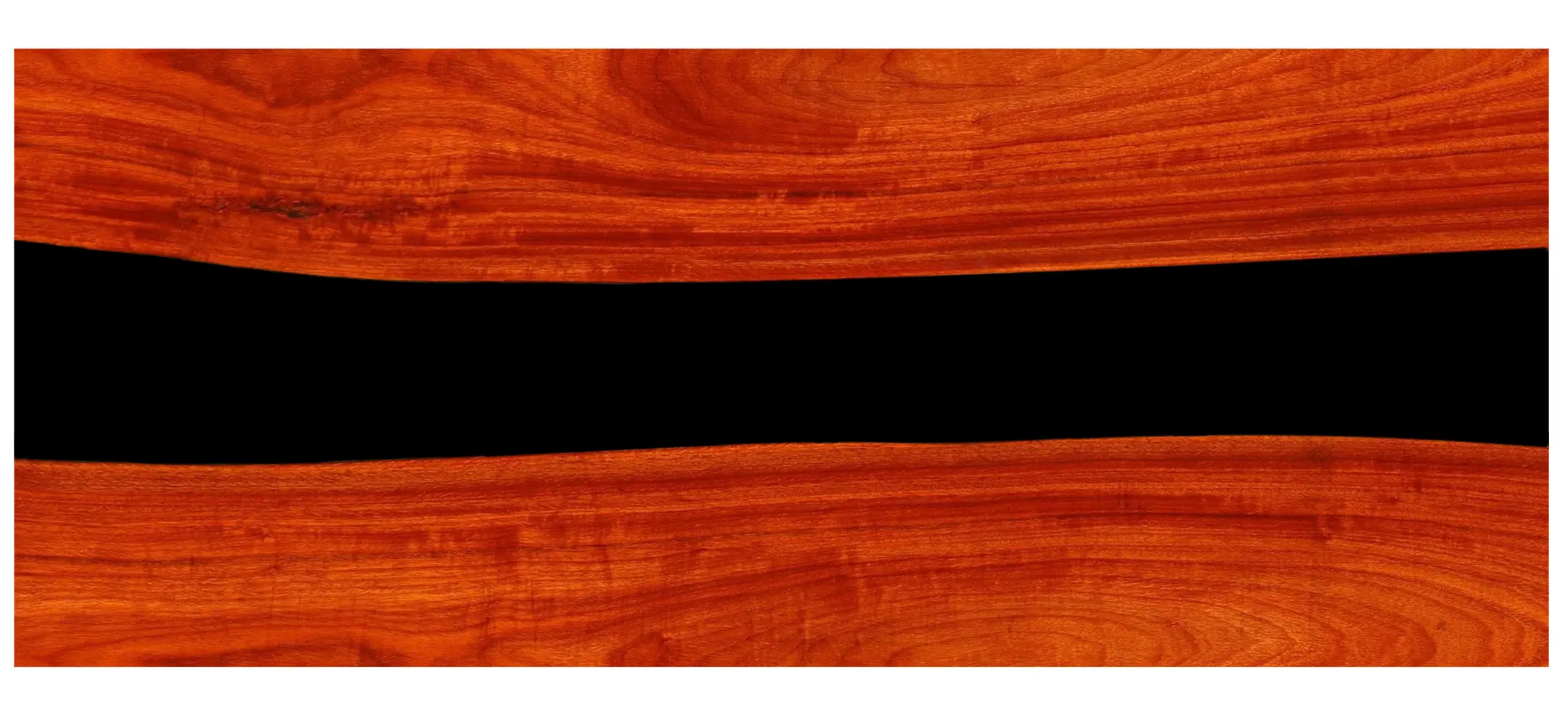
Padauk River Table
A beautiful freshly milled Padauk River Table
Legs
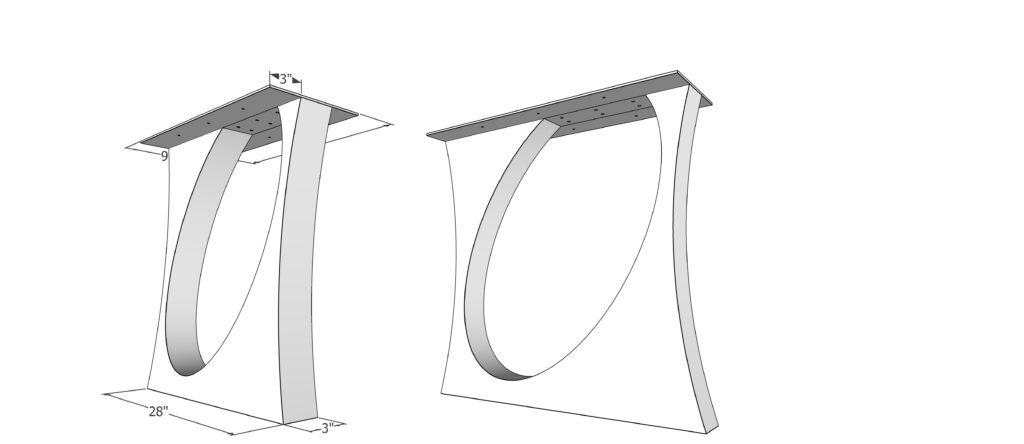
I also knew the exact style of legs (I wanted) for this piece. I reached out to one of our metalworking/blacksmithing suppliers. They supply most of our legs because they deliver quality and speed at a very reasonable price. He sent me back this drawing this morning. Making me even more excited about creating this river table.
I imagine these legs in a flat black powder coat finish. Powder coating is very durable and because it is flat, I don’t think the legs take anything away from the table. In fact, they complement each other. Combined this table is a work of art. If you don’t want black, our leg suppliers offer 1000s of colors and many finishes. This tabletop was meant to go on these legs, don’t ya think?
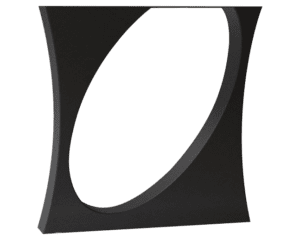
A quick render of what the legs would look like in a flat black powder coat.
Padauk, an exotic hardwood
I can’t express how excited I was when I saw this ‘River Table’ in waiting. I took pictures of the slab and I sent them to my kids and my sister. Who does that? Someone that is truly excited, that’s who.
There are somethings to touch on here. My sister brought this to my attention first. She said, “It’s modern! Red”, then she said, “I never had any luck selling anything red”, “Even Mahogany stuff sits for me”. So, lets first, change that! Red is beautiful. Mahogany is stunning!
With that said, for those that don’t know much about Padauk. It tends to lose its orange and red tones and darkens over time, especially when exposed to sun light.
Finishing the River Table
We have two paths to travel. One is to embrace the darkening and one is to mitigate it as much as we can.
Path one, embracing the aging process. We would recommend finishing this in a conventional way. A few coats of dewaxed shellac and a good old fashioned Tung oil varnish (fig 1) on top of the shellac. Or a beautiful hand rubbed Tung oil finish by itself (fig 2). This would then allow the slab to darken over time.
The two images below, I believe, represent the two different types of finishes and what this River Table would look like over time.
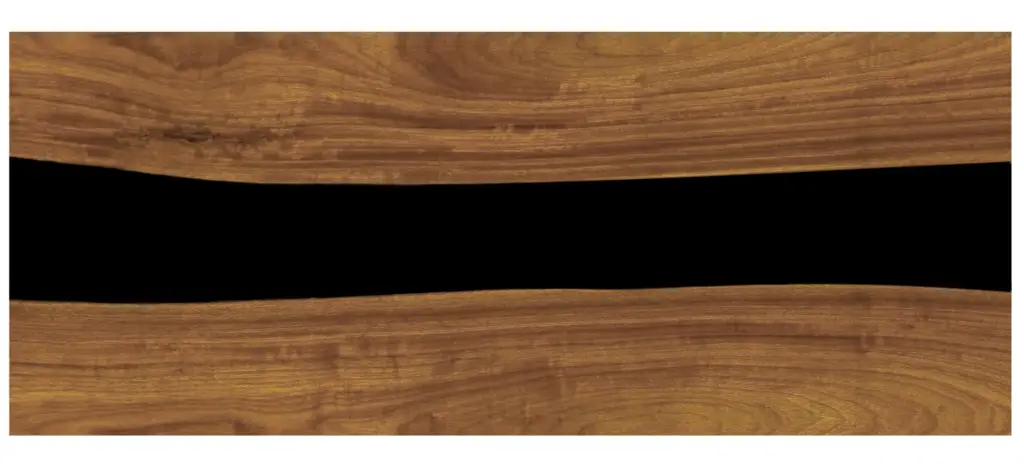
Dewaxed shellac and a good old fashioned Tung oil
Fig 1
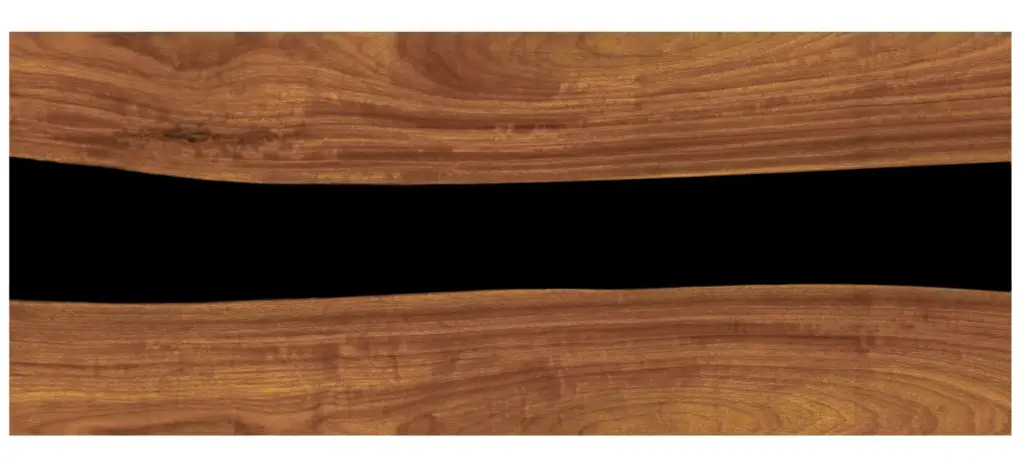
Rubbed Tung oil finish by itself
Fig 2
The other path, path two, mitigate the aging process, fight the darkening effect. Add a UV coating to the finish. Adding UV protection will extend the life of the orange and red tones and lessen the darkening over time. I would still add a few coats of dewaxed shellac and then a high-quality Marine Spar Varnish like this Varnish from TotalBoat’s Gleam 2.0. For this particular River Table, I think I would go with the satin finish, but I will leave that up to the buyer. Either way, the performance of this table will last for years.
For those of us that don’t mind some red in our life.
Padauk like most other colored woods loses its color over time. If the buyer of this piece wants the red, and embraces the red, we can dye the wood before finishing which would actually lengthen the time this epoxy river table maintains its natural coloring by a great margin.
River
When I originally was thinking about turning this slab into an river epoxy table, I envisioned the river black. That is why the renderings of the river dining table are all black. But in reality the river, as in any river table Dovetails and Stitches create, can be any color the buyer wants. The river does not need to be opaque either, it can be transparent or semi-transparent as the owner sees fit. I only have it rendered in black so we can see the possibilities, I have also this rendered with a very modern set of legs for this epoxy wood dining table, again, I will work with the buyer to choose the hardware and legs that fit their style, their home or office. One other item to mention is that Padauk has a high oil content. What that means from a timing perspective is that this piece will take a little bit longer to make as drying times are much longer with oily woods. As always, all our Epoxy Tables come with heavy duty C channel on the underside of the table to diminish cupping. I estimate the price for this epoxy river table (as described above) to be approximately $9400 plus shipping. So, who wants a Epoxy River Table made from figured Padauk? Take the first step, click or call today. By the way, this feeling that I have. That is exactly why I am in woodworking!
FAQs
Padauk wood is naturally durable and has moderate resistance to moisture and decay. However, it is not considered highly water resistant and should be protected from prolonged exposure to water or moisture.
Yes, padauk wood is known for its beautiful reddish-orange color and unique grain pattern, which makes it a popular choice for furniture making. It is a dense and durable hardwood that can be used for a wide range of furniture styles, including tables, cabinets, and chairs.
Padauk wood is known for its excellent workability, stability, and durability. It has a fine to medium texture with a straight to interlocked grain pattern, which makes it relatively easy to work with hand or machine tools. It takes stains and finishes well, resulting in a smooth and lustrous surface.
As you read in this blog, over time and with exposure to sunlight, the color of padauk wood may darken and develop a deeper reddish-brown hue. This natural color change is a characteristic of padauk wood.
Padauk wood is native to various countries in tropical regions, including parts of Africa, Southeast Asia, and Central and South America. It is commonly found in countries such as Cameroon, Ghana, Nigeria, Myanmar, Thailand, and India.
Yes, padauk wood is considered an exotic hardwood due to its unique color, grain pattern, and origin. It is not commonly found in temperate regions and is typically imported from tropical countries for woodworking and furniture making.
Padauk wood is often associated with qualities such as strength, durability, and boldness. In some cultures, it is believed to symbolize protection, grounding, and stability. It is also known to represent energy, power, and passion due to its vibrant color.
Some interesting facts about padauk wood include:
1) It is known for its striking reddish-orange color, which can darken to a reddish-brown hue with age and exposure to sunlight.
2) Padauk wood is dense and durable, making it suitable for a wide range of applications, including furniture making, flooring, cabinetry, and musical instruments.
3) It is often used in woodworking projects that require stability, such as boat building, due to its resistance to rot, decay, and insect attack.
4) Padauk wood has a unique interlocked grain pattern, which adds to its visual appeal and makes it a sought-after choice for decorative woodworking.
5) Padauk wood is listed as a vulnerable species due to overharvesting and deforestation in some regions, and it is important to source padauk wood from sustainable and responsibly managed forests.
While some species of padauk wood are listed as vulnerable or near-threatened on the IUCN Red List due to overharvesting and deforestation, the status of padauk wood varies depending on the specific species and the region where it is harvested. It is important to source padauk wood from reputable and sustainable sources to ensure its responsible and ethical use in woodworking projects.
Padauk wood is native to tropical regions in various countries, including parts of Africa, Southeast Asia, and Central and South America. It can be found in countries such as Cameroon, Ghana, Nigeria, Myanmar, Thailand, India, and other countries with suitable climatic conditions for its growth.
Hard, but Padauk wood is not recommended for prolonged outdoor use without proper protection. While it has moderate resistance to moisture and decay, it is not considered highly water resistant and can be susceptible to damage from exposure to harsh weather conditions. To ensure the longevity and durability of padauk wood in outdoor applications, it should be properly sealed, finished, and maintained with appropriate protective coatings.
Yes, padauk wood can be used for flooring due to its density, durability, and beautiful color. However, it is important to properly acclimate and install padauk wood flooring according to industry standards to ensure its stability and performance over time. Padauk wood flooring can add a unique and exotic touch to interior spaces, but it requires regular maintenance and care to preserve its appearance and integrity.


